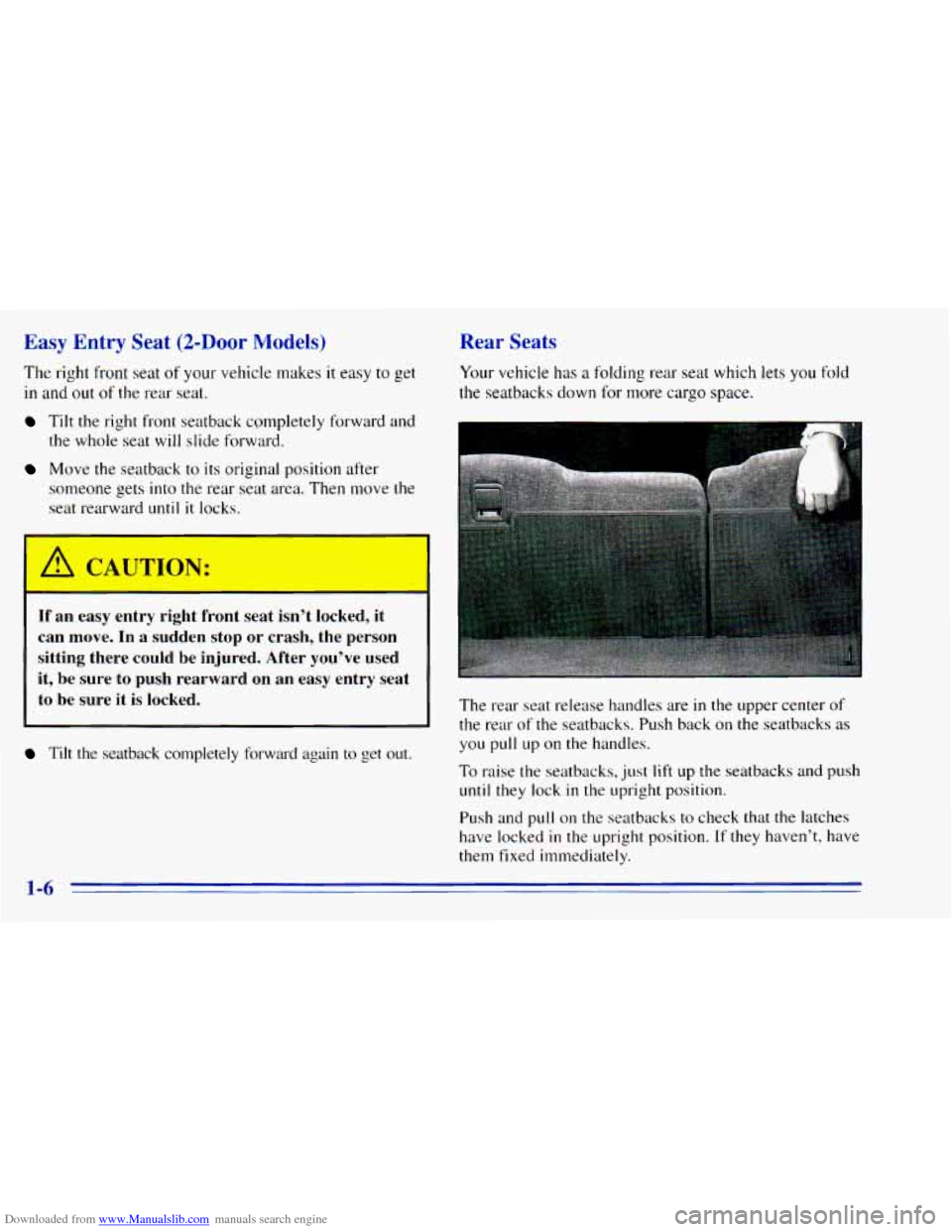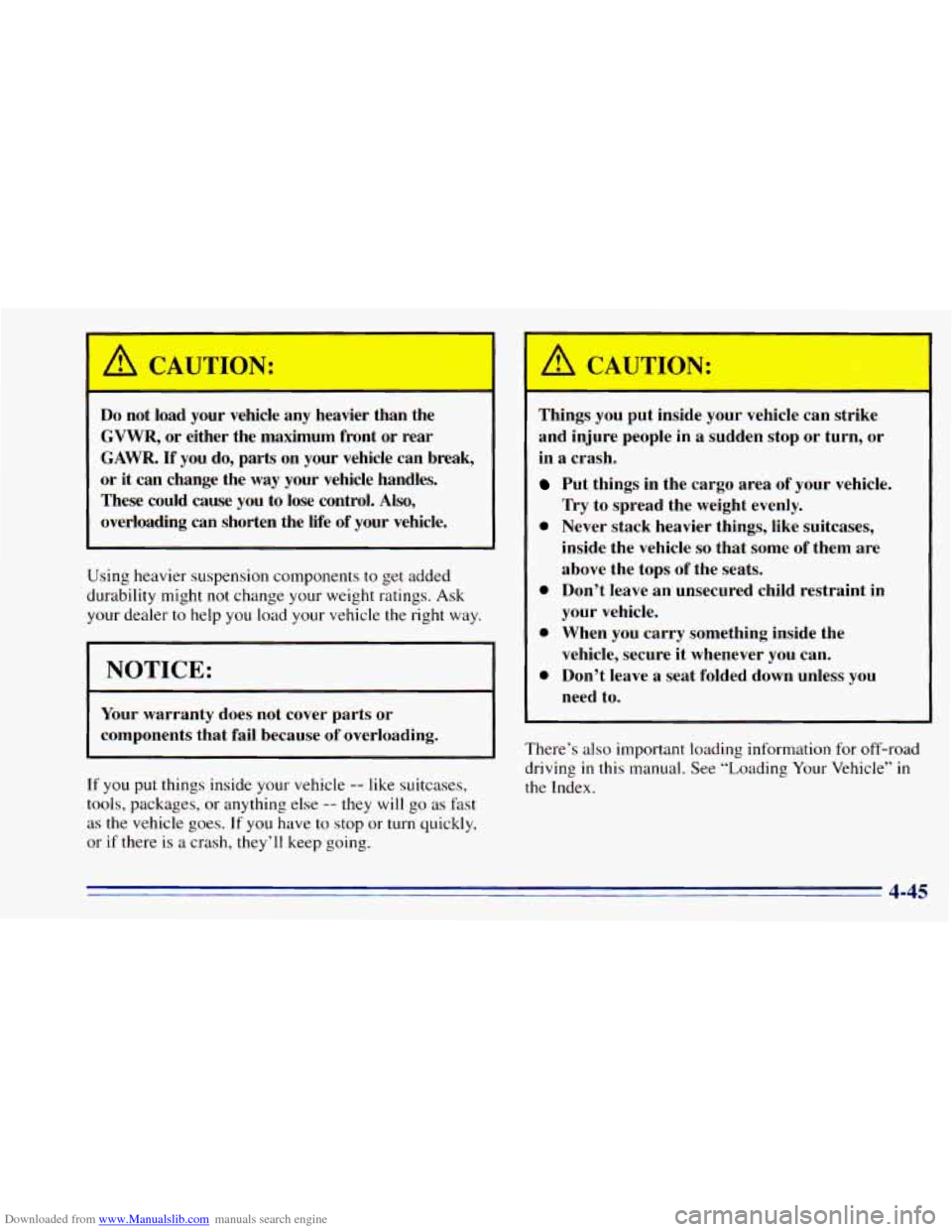Page 13 of 392
Downloaded from www.Manualslib.com manuals search engine Section 1 Seats and Restraint Systems
Here you’ll find information about the seats in your
vehicle and how
to use your safety belts properly. You
can also learn about some things you should not do with
air bags and safety belts.
Seats and Seat Controls
This section tells you about the seats -- how to adjust
them, and fold them up and down.
Manual Front Seat
You can lose control of the vehicle if you try to
adjust a manual driver’s seat while the vehicle is
moving. The sudden movement could startle and
confuse you, or make you push a pedal when you
don’t want
to. Adjust the driver’s seat only when
the vehicle
is not moving.
Move the lever under the
front of the standard seat
toward the driver’s door to
unlock
it. Slide the seat to
where
you want it. Then
release the lever and try to
move the seat with your
body,to make sure the seat
is locked into place.
1-1
Page 18 of 392

Downloaded from www.Manualslib.com manuals search engine Easy Entry Seat (2-Door Models)
The right front seat of your vehicle makes it easy to get
in
and out of the rear seat.
Tilt the right front seatback completely forward and
Move the seatback to its original position after
the whole seat
will slide
forward,
someone gets into the rear seat area. Then move the
seat rearward
until it locks.
If an easy entry right front seat isn’t locked, it
can move. In a sudden stop or crash, the person
sitting there could be injured. After you’ve used
it, be sure to push rearward on an easy entry seat
to be sure it
is locked.
Rear Seats
Your vehicle has a folding rear seat which lets you fold
the seatbacks down for more cargo space.
Tilt the seatback completely forward again to get out. The rear seat release handles
are
in the upper center of
the rear
of the seatbacks. Push back on the seatbacks as
you pull up on the handles.
To raise the seatbacks, just
lift up the seatbacks and push
until they lock in the upright position.
Push and pull on the seatbacks to check that
the latches
have locked
in the upright position. If they haven’t, have
them fixed immediately.
1-6
Page 199 of 392

Downloaded from www.Manualslib.com manuals search engine A CAUTION:
= 1
Do not load your vehicle any heavier than the
GVWR, or either the maximum front or rear
GAWR.
If you do, parts on your vehicle can break,
or it can change the
way your vehicle handles.
These could cause you to lose control.
Also,
overloading can shorten the life of your vehicle.
Using heavier suspension components to get added
durability might not change your weight ratings. Ask
your dealer to help you load your vehicle the right way.
NOTICE:
Your warranty does not cover parts or
components that fail because of overloading.
~~
If you put things inside your vehicle -- like suitcases,
tools, packages, or anything else -- they will go as fast
as the vehicle goes. If you have to stop or turn quickly,
or if there
is a crash, they’ll keep going.
A CAUTION: ..,
Things you put inside your vehicle can strike
and injure people in
a sudden stop or turn, or
in a crash.
Put things in the cargo area of your vehicle.
0 Never stack heavier things, like suitcases,
Try to spread the weight evenly.
inside the vehicle
so that some of them are
above the tops
of the seats.
0 Don’t leave an unsecured child restraint in
your vehicle.
0 When you carry something inside the
vehicle, secure it whenever you can.
0 Don’t leave a seat folded down unless you
need to.
There’s also important loading information for off-road
driving
in this manual. See “Loading Your Vehicle” in
the Index.
4-45